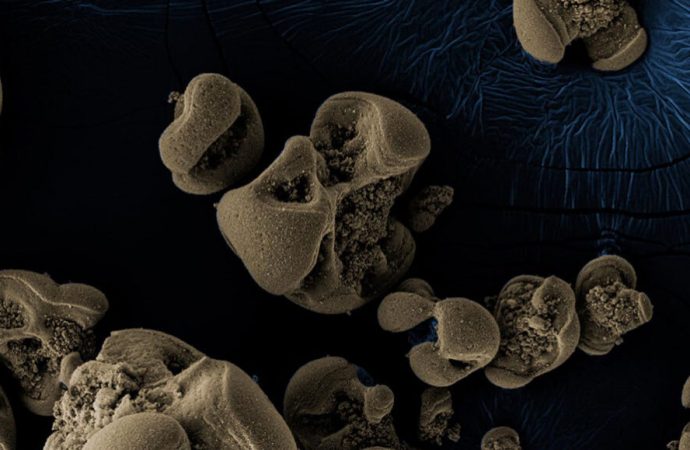Two species of bacteria left telltale manganese metal pebbles in a dirty lab jar left to soak
Source: Science News
Scientists have discovered the first bacteria known to use the metal manganese to grow. And the researchers had to look only as far as the office sink.
“It’s definitely an interesting story about serendipity,” says Jared Leadbetter, an environmental microbiologist at Caltech. He and Hang Yu, also an environmental microbiologist at Caltech, report their fortuitous find in the July 16 Nature.
Leadbetter had been working with a pink compound called manganese carbonate in a glass jar. After having trouble cleaning the jar, he filled it with tap water and left it to soak. When he returned 10 weeks later, after an out-of-town teaching stint, the contents of the jar had transformed into a dark, crusty material.
Leadbetter knew that scientists had long suspected that bacteria could use manganese to fuel growth. Over a century ago, researchers discovered that bacteria could borrow electrons from chemical elements like nitrogen, sulfur, iron — and manganese. In some cases, bacteria could even use these electrons to fuel growth in much the same way that humans use electrons from carbohydrates in the diet for energy. But no one had identified bacteria that could turn electrons from manganese into energy.
When bacteria do borrow electrons from manganese, they convert the metal to a dark material called manganese oxide. Manganese oxide is found all over the planet — from deposits in Earth’s crust to the seafloor to drinking water. And, as it turned out, in Leadbetter’s glass jar.
He wondered if the bacteria that had oxidized his manganese might be the elusive species that actually use manganese to grow. “Maybe I better not pour this down the sink,” he thought.
Leadbetter and Yu first identified about 70 bacterial species in the jar, which likely came from the tap water. The pair then isolated two bacterial species that, when present together, generate manganese oxide. Given manganese carbonate, these bacteria multiplied exponentially. As the bacterial population size increased, the rate of manganese oxide production increased along with it, suggesting that the bacteria were using manganese as fuel.
The team dubbed the newly identified species ‘Candidatus Manganitrophus noduliformans’ and Ramlibacter lithotrophicus. The researchers don’t yet know the exact role of each species. Both might be integral in generating energy from the manganese or one could be the main driver.

The findings could help researchers manage manganese oxide that pollutes drinking water, says Amy Pruden, an environmental scientist at Virginia Tech in Blacksburg who was not involved in the study. “Now that we have an idea of who the manganese oxidizers are, we can start looking for them in drinking water systems and maybe we can find better controls.”
Leadbetter suspects that similar bacteria may also be responsible for grapefruit-sized balls of manganese oxide on the ocean floor, first spotted in the 1870s, that have puzzled scientists. He wants to search there and other places for more examples of bacteria that use manganese for energy.
“Let’s see if we can find these organisms in other environments,” Leadbetter says. “Not just my sink.”
Source: Science News

































Leave a Comment
You must be logged in to post a comment.